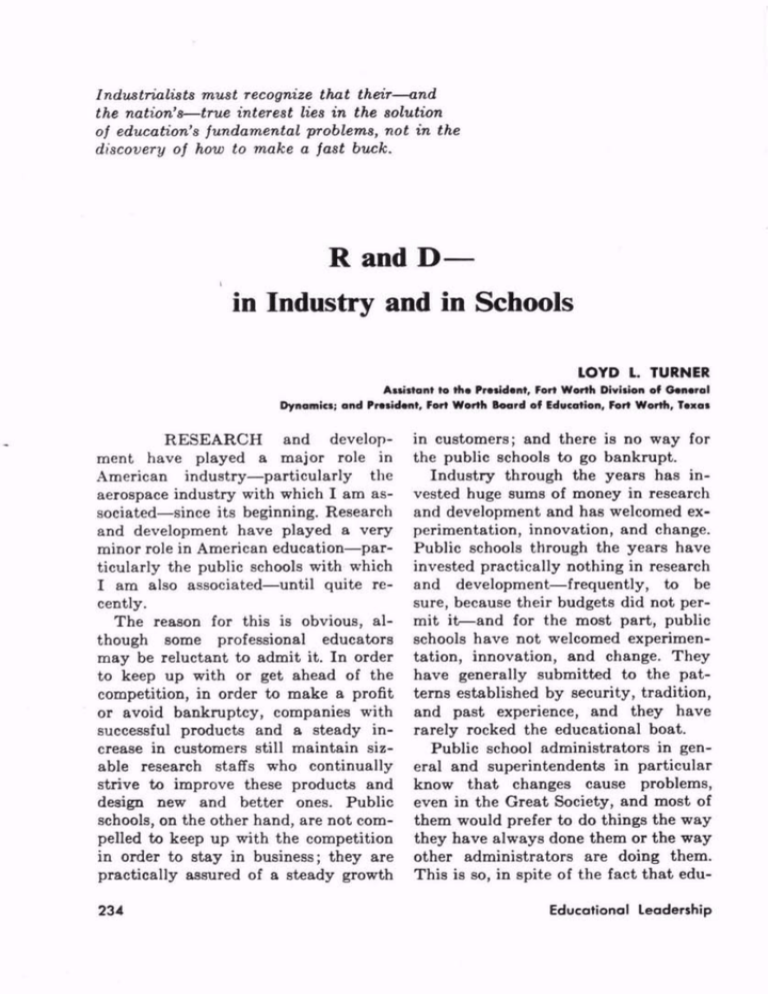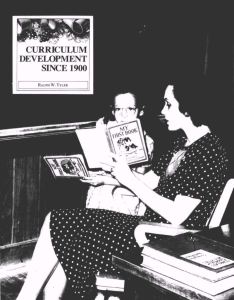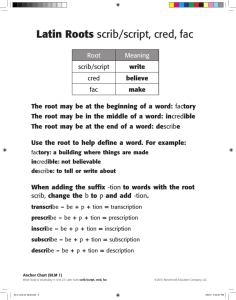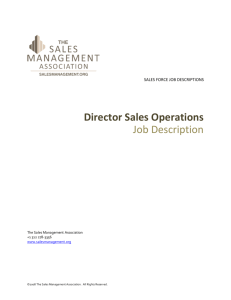
Industrialists must recognize that their—and
the nation's—true interest lies in the solution
of education's fundamental problems, not in the
discovery of how to make a fast buck.
R and D—
in Industry and in Schools
LOYO L. TURNER
Assistant to th* President, Fort Worth Division of General
Dynamics; and President. Fart Worth Board el Education, Fort Worth, Texas
RESEARCH and develop
ment have played a major role in
American industry particularly the
aerospace industry with which I am as
sociated since its beginning. Research
and development have played a very
minor role in American education par
ticularly the public schools with which
I am also associated until quite re
cently.
The reason for this is obvious, al
though some professional educators
may be reluctant to admit it. In order
to keep up with or get ahead of the
competition, in order to make a profit
or avoid bankruptcy, companies with
successful products and a steady in
crease in customers still maintain siz
able research staffs who continually
strive to improve these products and
design new and better ones. Public
schools, on the other hand, are not com
pelled to keep up with the competition
in order to stay in business; they are
practically assured of a steady growth
234
in customers; and there is no way for
the public schools to go bankrupt.
Industry through the years has in
vested huge sums of money in research
and development and has welcomed ex
perimentation, innovation, and change.
Public schools through the years have
invested practically nothing in research
and development frequently, to be
sure, because their budgets did not per
mit it and for the most part, public
schools have not welcomed experimen
tation, innovation, and change. They
have generally submitted to the pat
terns established by security, tradition,
and past experience, and they have
rarely rocked the educational boat.
Public school administrators in gen
eral and superintendents in particular
know that changes cause problems,
even in the Great Society, and most of
them would prefer to do things the way
they have always done them or the way
other administrators are doing them.
This is so, in spite of the fact that eduEducational leadership
cators, of all people, should realize that
there is no security in conformity for
the sake of conformity, and there is no
lasting tranquility in the company of
the herd.
Resistance to Change
Let us go from the general to the
specific. Several years ago before the
federal government jumped into educa
tion research with both feet and mil
lions of dollars the Forth Worth
Board of Education put into its annual
budget $50,000 to be used for research
and development, particularly in the
curriculum area. At budget-making
time the following year, the board
learned that the superintendent and his
staff had spent only a small fraction of
the money, apparently thinking that
the board would commend them for
their frugality. Instead, the board
chided them for missing the opportunity
which the research and development
money represented, and the board
placed a similar amount of money for
research and development in the follow
ing year's budget and instructed the
superintendent and his staff to spend
it for this purpose.
Our school administrators in Fort
Worth were probably no less interested
in research and development and no
more opposed to change than the
average school administrator, whoever
and wherever he might be. I might add
that these administrators have now set
a goal of devoting one percent of the
annual budget to research and develop
ment by 1978. They realize that in
order to create an educational climate
conducive to change, in order to break
the shackles of tradition that stifle
creativity and innovation, they must
December 1 967
include in the budget adequate funds
for research and development.
(Before proceeding further, I would
like to make clear that these are my
views. They do not necessarily reflect
the views of General Dynamics or the
Fort Worth Board of Education.)
Funds for Research
Industries in the United States sup
ported research and development in
1965 to the tune of more than $14
billion. The aerospace industry 'alone,
counting both federal and company
funds, invested more than $5 billion in
research and development. Figures for
1966 and 1967 are slightly higher, and
Business Week predicted in its May 13
issue that by 1970 industry will be
spending more than $20 billion an
nually on research and development.
Federal expenditures for educational
research in 1965 totaled only $69.8
million. State expenditures for this pur
pose were $11 million, and local school
districts spent $3 million on research.
These millions spent for educational
research in 1965 represent a tremendous
increase over what was spent five years
earlier. Even so, these expenditures are
a drop in the bucket compared to the
billions spent by industry in 1965 for
research and development. As a matter
of fact, some individual corporations
notably International Business Ma
chines spent more for research and
development in 1965 than the $69.8
million spent by all federal agencies
for educational research.
In the past two years, however, the
amount of money being spent on re
search and development in education
has increased appreciably, primarily
because more federal funds are now
235
available for this purpose. In the past,
most public school systems have not
had the money and many have not had
the inclination to do much research
and development.
The federal government is now pro
viding both the funds and the stimulus.
The long-range results of this type of
federal participation will probably be
good for public education, regardless of
how some other federally aided educa
tion projects may pan out.
cation contracted only with universi
ties, colleges, and other non-profit in
stitutions for research in education.
After the act was passed, however, the
Office of Education began contracting
with industrial firms and other profitmaking organizations for such research
and development.
This romance between the Office of
Education and big business may prove
to be one of the most significant de
velopments in modern education.
Research and Change
Why? Because research and develop
ment, long neglected in public educa
tion, are the best methods for promot
ing change. Research will move from
the wings of education to stage center.
Inventors, engineers, product testers,
and disseminators will join the more
conventional researchers. Centers of
research and development will emerge
on a scale beyond anything currently in
existence, and I am not referring solely
to the regional educational laboratories.
Some of the results of this educa
tional research will be useful; some will
not. The situation could hardly be
otherwise, if one admits that occasion
ally federal grants are based more upon
brochuremanship than upon any crying
need in public education.
More than two-thirds of the total
national research effort is supported by
federal funds; and three-fourths of the
nation's total research and development
effort is done by industry. Until re
cently, however, industry had prac
tically nothing to do with federally
aided research in education.
Prior to the passage of the Elemen
tary and Secondary Education Act of
1965, the United States Office of Edu
Warning Sounded
Many people in and out of education
are concerned, however, that the power
of this federal "carrot" in the hands of
the Office of Education which can
now contract directly with profit-mak
ing organizations for educational re
search and development can largely
determine which development programs
will be undertaken in education.
Others fear that decisions which
should be made by educators will be
made by industrialists. The subcom
mittee of the Joint Economic Committee
of the House and Senate, after its June
1966 hearing on technology in educa
tion, issued this warning:
236
It appears that the vital function of pro
gramming preparation of content of edu
cation is falling too frequently on the
hardware manufacturers when it should be
handled by educational experts. It would be
tragic if control of curriculum and content
of courses were to pass by default into the
hands of large corporate producers of the
hardware and software end of the business.
We should not lose sight of the fact
that the funds for educational research
are only a small portion of what the
federal government is spending in the
general area of education. During fiscal
Educational Leadership
1966, the United States Office of Educa
tion listed 67 different federal programs
supporting educational efforts of one
kind or another with a total funding
of more than $3 billion.
This burgeoning education market
has attracted some of the major cor
porations and industrial organizations
in the nation, particularly computer
manufacturers.
Education has now learned what
industry learned some time ago a
computer is no better than the informa
tion fed into it. (The acronym GIGO
stems from this fact: "Garbage in, gar
bage out.") Right now, electronic hard
ware for education is much further ad
vanced than electronic software.
This deficiency in software, however,
is going to be corrected in the years
ahead, as one of the positive results of
recent mergers between computer
manufacturers and book publishers and
the golden promises surrounding com
puter-assisted instruction.
Computer-Based Instruction
A good example is the Radio Cor
poration of America, which merged last
year with Random House, reflecting
their "conviction that publishing and
electronics are natural partners for the
incredible expansion immediately ahead
for every phase of education in our
country." Earlier this year RCA an
nounced its full-scale entry into the
field of computer-based instruction,
with the formation of RCA Instruc
tional Systems in Palo Alto, California.
Working closely with a group of Stan
ford University educators, the center is
developing new curriculum devices and
combining computers, communications
channels, and display terminals into a
December 1967
system capable of teaching the student
as an individual.
According to Robert W. Sarnoff,
RCA president, this system will make
possible rates of learning and retention
far greater than any other teaching
technique. "It avoids, moreover, the
rigid system of learning by rote, sub
stituting, instead, emphasis on the de
velopment of flexible skills that the
modern student will need throughout a
lifetime requirement of continuing edu
cation," he said at the dedication cere
monies for the new center.
RCA is only one of many corpora
tions and industrial organizations in
terested in the educational market.
Opportunities and Obligations
This education-industry mix in the
United States obviously affords oppor
tunities; but, less obviously, it imposes
obligations. Educators must recognize
the complexity of the present and fu
ture educational task and must under
stand how the new technology can help
them successfully meet it. Industrialists
must recognize that their and the na
tion's true interest lies in the solution
of education's fundamental problems
not in the discovery of how to make a
fast buck in an expanding educational
market.
Optimists believe that this blending
of education, federal funds, research
and development, and industry will be
good for the nation. Pessimists believe
that this blending while it may jar
education loose from some of its rutted
practices may also result in too much
federal control of education.
The truth and even the computers
do not know it yet probably lies some
where in between.
««§
237
Copyright © 1967 by the Association for Supervision and Curriculum
Development. All rights reserved.












